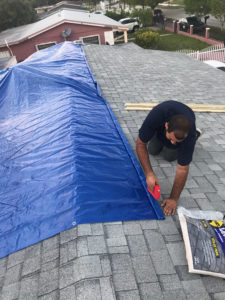Lay the tarp out flat over the roof.
How to keep tarp on roof.
When installed correctly roof tarps can shield you home from bad weather for up to 90 days.
If the tarp doesn t extend over the peak of the roof water can get underneath the tarp rending it useless.
Lay the tarp across the roof so that at least 4 feet 1 2 m lies on the sloped part of your roof on each side known as the peak.
Overlap the ridge line with the tarp by about 2 feet.
This is so the roof will deflect water either on one side or the other.
Purchase a tarp that will cover completely cover the area with 2 or 3 feet to spare on all sides.
Then fold the excess tarp under a few rotations for a tight clean fit.
It s important to report the damage to your insurance company as soon as possible and take plenty of pictures.
In the aftermath of a hurricane tornado severe storm falling tree limbs or other cause of roof damage.
Danny lipford demonstrating how to secure a tarp to a storm damaged roof.
Tarping a roof will temporarily stop leaks and protect your home from the elements.
Lay more 2 by 4s on either side of the tarp and attach those as well for a tight well secured water barrier.
If required cut plywood as needed cover up any existing penetrations with plywood secure the perimeter with screws every 6 to 12 into the roof sheathing below preferably into trusses unroll the full tarp make sure that the length extends 1 past the edge of the roof on the damaged side.
Let the rest of the tarp hang off the lower border of the roof that overhangs the wall known as the eave.
Screw the 2 by 4 directly into the roof to secure it.
This will keep you dry until you can fix the issue or have a professional team make repairs.
The 2 by 4 should be about 2 feet longer than the tarp width.
Never lay the tarp out during a storm.
If you don t cover the ridge line the tarp won t be effective at keeping out water.

